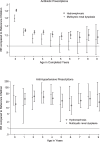Morbidity in children with major kidney anomalies: a European population-based study
- PMID: 40495087
- PMCID: PMC12152065
- DOI: 10.1007/s00431-025-06232-3
Morbidity in children with major kidney anomalies: a European population-based study
Abstract
Knowledge about the prognosis for children born with congenital anomalies is important for counselling parents after a prenatal diagnosis. Nine population-based European Congenital Anomaly registries provided data on all children born 1995-2014 diagnosed with congenital hydronephrosis, multicystic kidney disease (MCKD), or posterior urethral valves (PUV) and on reference children from the same populations. Data up to 2015 on prescriptions, hospital diagnosis, and surgical procedures up to the 10th birthday were obtained by linkage to prescription and hospital databases. The study included 5624 children diagnosed with congenital hydronephrosis, 1314 with MCKD, and 414 with PUV. Children with hydronephrosis or MCKD were 13 times more likely to have prescriptions for antihypertensives compared to reference children before 10 years of age. Around 3% of children with congenital hydronephrosis or MCKD had a diagnosis of kidney failure at the age of 5 years; however, only 1% had a kidney transplantation by the age of 5 years. For children with PUV, 18.3% had a diagnosis of kidney failure and 5% had a kidney transplantation by the age of 5 years.
Conclusion: Children born with congenital hydronephrosis and MCKD generally have a low absolute risk of developing kidney failure. Children with PUV have much higher morbidity, with 1 in 5 (18.3%) being diagnosed with kidney failure before the age of 5 years. It is important to monitor these children closely in early childhood in order to prevent or delay kidney failure.
What is known: • Congenital kidney anomalies are a leading cause of pediatric end-stage kidney disease. Children with hydronephrosis, MCKD, and PUV have increased morbidity, but long-term data on medication use and kidney outcomes are limited.
What is new: • This population-based study shows a low absolute risk of kidney failure in children born with hydronephrosis or MCKD but a high relative risk. PUV has high morbidity, with 1 in 4 developing kidney failure by age 10. Antibiotic use is high in early childhood, and antihypertensive use increases with age.
Keywords: Congenital hydronephrosis; Kidney failure; Kidney transplantation; Multicystic kidney dysplasia; Posterior urethral valves.
© 2025. The Author(s).
Conflict of interest statement
Declarations. Ethics approval: All EUROCAT registries obtained ethical and other permissions for the data linkage according to their national legislations. University of Ulster obtained ethics permission for the Central Results Repository on 15 September 2017 (Institute of Nursing and Health Research Ethics Filter Committee, number FCNUR-17–000). Conflict of interest: The authors declare no competing interests.
Figures
Similar articles
-
Surgical interventions for bilateral congenital cataract in children aged two years and under.Cochrane Database Syst Rev. 2022 Sep 15;9(9):CD003171. doi: 10.1002/14651858.CD003171.pub3. Cochrane Database Syst Rev. 2022. PMID: 36107778 Free PMC article.
-
A rapid and systematic review of the clinical effectiveness and cost-effectiveness of paclitaxel, docetaxel, gemcitabine and vinorelbine in non-small-cell lung cancer.Health Technol Assess. 2001;5(32):1-195. doi: 10.3310/hta5320. Health Technol Assess. 2001. PMID: 12065068
-
123I-MIBG scintigraphy and 18F-FDG-PET imaging for diagnosing neuroblastoma.Cochrane Database Syst Rev. 2015 Sep 29;2015(9):CD009263. doi: 10.1002/14651858.CD009263.pub2. Cochrane Database Syst Rev. 2015. PMID: 26417712 Free PMC article.
-
Palivizumab for immunoprophylaxis of respiratory syncytial virus (RSV) bronchiolitis in high-risk infants and young children: a systematic review and additional economic modelling of subgroup analyses.Health Technol Assess. 2011 Jan;15(5):iii-iv, 1-124. doi: 10.3310/hta15050. Health Technol Assess. 2011. PMID: 21281564 Free PMC article.
-
Prenatal interventions for congenital diaphragmatic hernia for improving outcomes.Cochrane Database Syst Rev. 2015 Nov 27;2015(11):CD008925. doi: 10.1002/14651858.CD008925.pub2. Cochrane Database Syst Rev. 2015. PMID: 26611822 Free PMC article.
References
-
- Dharnidharka VR, Fiorina P, Harmon WE (2014) Kidney transplantation in children. NEJM 371:549–558 - PubMed
-
- Harada R, Hamasaki Y, Okuda Y et al (2022) Epidemiology of pediatric chronic kidney disease/kidney failure: learning from registries and cohort studies. Pediatr Nephrol 37:1215–1229. 10.1007/s00467-021-05145-1 - PubMed
-
- Winding L, Loane M, Wellesley D et al (2014) Prenatal diagnosis of epidemiology of multicystic kidney dysplasia in Europe. Prenat Diagn 34:1093–1098 - PubMed
-
- Yadav P, Rickard M, Kim JK, Richter J, Lolas M, Alshammari D et al (2022) Comparison of outcomes of prenatal versus postnatal presentation of posterior urethral valves: a systematic review and meta-analysis. World J Urol 40:2182–2194 - PubMed
MeSH terms
Grants and funding
LinkOut - more resources
Full Text Sources


